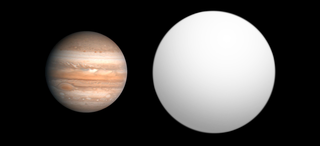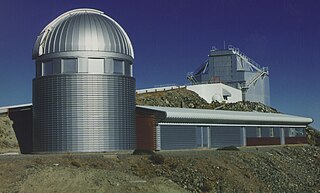Artie P. Hatzes | |
|---|---|
| Born | May 24, 1957 |
| Nationality | American |
| Alma mater | California Institute of Technology University of California at Santa Cruz |
| Known for | Discovering numerous extrasolar planets |
| Scientific career | |
| Fields | Astronomy |
| Institutions | Karl Schwarzschild Observatory |
Artie P. Hatzes (born May 24, 1957) is an American astronomer. He is a professor at the Friedrich Schiller University of Jena and director of the Karl Schwarzschild Observatory (Thuringian State Observatory).
Hatzes is a pioneer in the search of extrasolar planets and is working on the COROT space mission. His achievements have included discovering the extrasolar planets Pollux b, Epsilon Eridani b and HD 13189 companion.

2M1207b is a planetary-mass object orbiting the brown dwarf 2M1207, in the constellation Centaurus, approximately 170 light-years from Earth. It is one of the first candidate exoplanets to be directly observed. It was discovered in April 2004 by the Very Large Telescope (VLT) at the Paranal Observatory in Chile by a team from the European Southern Observatory led by Gaël Chauvin. It is believed to be from 3 to 10 times the mass of Jupiter and may orbit 2M1207 at a distance roughly as far from the brown dwarf as Pluto is from the Sun.

WASP or Wide Angle Search for Planets is an international consortium of several academic organisations performing an ultra-wide angle search for exoplanets using transit photometry. The array of robotic telescopes aims to survey the entire sky, simultaneously monitoring many thousands of stars at an apparent visual magnitude from about 7 to 13.
ELODIE was an echelle type spectrograph installed at the Observatoire de Haute-Provence 1.93m reflector in south-eastern France for the Northern Extrasolar Planet Search. Its optical instrumentation was developed by André Baranne from the Marseille Observatory. The purpose of this instrument was extrasolar planet detection by the radial velocity method. This instrument was also used for the M-Dwarf Programmes.
Gamma Cephei Ab, formally named Tadmor, is an exoplanet approximately 45 light-years away in the constellation of Cepheus. The planet was confirmed to be in orbit around Gamma Cephei A in 2002, but was first suspected to exist around 1988.

Pollux b, also designated β Geminorum b and HD 62509 b, formally named Thestias, is an extrasolar planet approximately 34 light-years away in the constellation of Gemini. This planet was discovered orbiting the star Pollux in 2006 by astronomer Artie P. Hatzes, confirming his hypothesis originally published in 1993. The planet has at least twice the mass of Jupiter. It moves around Pollux in 1.61 years at a distance of 1.64 AU in a nearly circular orbit.

14 Herculis b or 14 Her b is an exoplanet approximately 58.5 light-years away in the constellation of Hercules. The planet was found orbiting the star 14 Herculis, with a mass that would likely make the planet a Jovian planet roughly the same size as Jupiter but much more massive. It was discovered in July 1998 by the Geneva Extrasolar Planet Search team. At the time of discovery it was the extrasolar planet with the longest orbital period, though longer-period planets have subsequently been discovered.

Doppler spectroscopy is an indirect method for finding extrasolar planets and brown dwarfs from radial-velocity measurements via observation of Doppler shifts in the spectrum of the planet's parent star.
The Geneva Extrasolar Planet Search is a variety of observational programs run by the Geneva Observatory at Versoix, a small town near Geneva, Switzerland. The programs are executed by M. Mayor, D. Naef, F. Pepe, D. Queloz, N.C. Santos, and S. Udry using several telescopes and instruments in the Northern and Southern Hemisphere and have resulted in the discovery of numerous extrasolar planets, including 51 Pegasi b, the first ever confirmed exoplanet orbiting a main-sequence star.

79 Ceti b is an extrasolar planet orbiting 79 Ceti every 75 days. Discovered along with HD 46375 b on March 29, 2000, it was the joint first known extrasolar planet to have minimum mass less than the mass of Saturn.

Epsilon Eridani b, also known as Ægir, is an exoplanet approximately 10.5 light-years away orbiting the star Epsilon Eridani, in the constellation of Eridanus. The planet was discovered in 2000, and as of 2019 remains the only confirmed planet in its planetary system. It orbits at around 3.5 AU with a period of around 7.4 years, and has a mass around 1.2 times that of Jupiter.
Eta2 Hydri b, commonly known as HD 11977 b, is an extrasolar planet that is approximately 217 light-years away in the constellation of Hydrus. The presence of the planet around an intermediately massive giant star provides indirect evidence for the existence of planetary systems around A-type stars.
Aldebaran b is a candidate exoplanet orbiting the orange giant star Aldebaran, 65 light-years away. It was initially detected in 1993, but was considered doubtful until 2015, when researchers came to a conclusion that there is likely an exoplanet orbiting Aldebaran, consistent with the original calculations, but also compatible with stellar activity. However, in 2019, new data placed doubts on its existence again.
The Extrasolar Planets Encyclopaedia is an astronomy website, founded in Paris, France at the Meudon Observatory by Jean Schneider in February 1995, which maintains a database of all the currently known and candidate extrasolar planets, with individual pages for each planet and a full list interactive catalog spreadsheet. The main catalogue comprises databases of all of the currently confirmed extrasolar planets as well as a database of unconfirmed planet detections. The databases are frequently updated with new data from peer-reviewed publications and conferences.

Leonhard Euler Telescope, or the Swiss EULER Telescope, is a national, fully automatic 1.2-metre (47 in) reflecting telescope, built and operated by the Geneva Observatory. It is located at an altitude of 2,375 m (7,792 ft) at ESO's La Silla Observatory site in the Chilean Norte Chico region, about 460 kilometers north of Santiago de Chile. The telescope, which saw its first light on 12 April 1998, is named after Swiss mathematician Leonhard Paul Euler.
CoRoT-7 is a binary star system. The primary, CoRoT-7A is a G-type main sequence star, slightly smaller, cooler, and younger than the Sun. It has an apparent magnitude of 11.67, fainter than Proxima Centauri, the nearest star to the Sun. This star is approximately 520 light-years away from the Solar System in the constellation Monoceros.
Chi Virginis b is an extrasolar planet which orbits the K-type giant star Chi Virginis, located approximately 294 light years away in the constellation Virgo. This planet has mass at least 11 times that of Jupiter and takes 835 days to orbit the star twice the distance as Earth from the Sun. This planet was discovered in July 2009 using the radial velocity method.
CoRoT-7c is an extrasolar planet which orbits the G-type main sequence star CoRoT-7, located approximately 489 light years away in the constellation Monoceros. It's either a super-Earth or a Neptune-like planet, orbiting at 0.046 AU from the star, taking 3.7 days or 89 hours to make one round trip around the star.
Gamma Leonis b is an extrasolar planet located 125.5 light years away in the constellation Leo, orbiting the giant star Gamma Leonis.

Alpha Centauri Bb was a proposed exoplanet orbiting the K-type main-sequence star Alpha Centauri B, located 4.37 light-years from Earth in the southern constellation of Centaurus, but there has not been enough evidence to support the claim.